ERS Charts of Note
Subscribe to get highlights from our current and past research, Monday through Friday, or see our privacy policy.
Get the latest charts via email, or on our mobile app for  and
and 
_450px.png?v=5784.3)
Tuesday, December 30, 2014
The severity and duration of the ongoing drought in California has raised concerns over its role in rising food prices at the grocery store, especially for fresh fruits and vegetables. In 2012, California produced nearly 50 percent (by value) of the nation’s vegetables and non-citrus fruit. Droughts in California are generally associated with higher retail prices for produce, but price increases are lagged due to the time it takes for weather conditions and planting decisions to alter crop production, which then influence retail prices. In 2005, following five years of drought, retail fruit prices rose 3.7 percent and retail vegetable prices increased 4 percent. Prices continued to rise in 2006, one year after drought conditions began to improve. However, other factors such as energy prices and consumer demand also affect retail produce prices. For example, prices for fresh produce fell in 2009 despite drought conditions, as the 2007-09 recession reduced foreign and domestic demand for many retail foods. As of October 2014, ERS analysts are forecasting fresh fruit prices to increase 4.5 to 5.5 percent in 2014 and vegetable prices to be 2 to 3 percent higher. This chart appears in the Food Prices and Consumers section of the 2014 California Drought page on the ERS website. Information on ERS’s food price forecasts can be found in ERS’s Food Price Outlook data product, updated October 24, 2014. Originally published Thursday October 30, 2014.
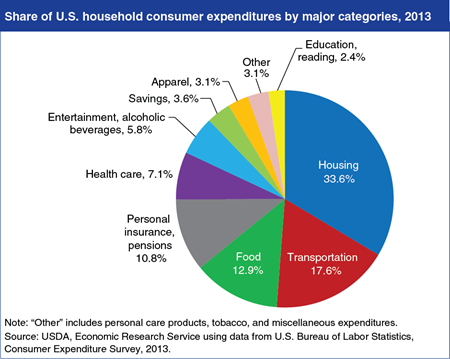
Tuesday, December 16, 2014
With a 12.9-percent share, food ranked third behind housing (33.6 percent) and transportation (17.6 percent) in a typical American household’s 2013 expenditures. Breaking down food spending further, 7.8 percent of expenditures were spent at the grocery store and 5.1 percent at restaurants. Price changes for the items in the different budget categories relative to each other play a role in the categories’ shares of annual household consumer expenditures. Over the last 10 years, retail food price inflation has often outpaced economy-wide inflation. Between 2004 and 2013, prices for all U.S. goods and services rose an average of 2.4 percent per year, while food prices increased an average of 2.8 percent. Despite higher food price inflation, food’s share of consumer expenditures fell slightly (0.4 percentage points) over the decade, as the budget shares for health care and housing rose. This chart appears in the ERS data product, Ag and Food Statistics: Charting the Essentials. More information on ERS’s food price forecasts can be found in ERS’s Food Price Outlook data product.
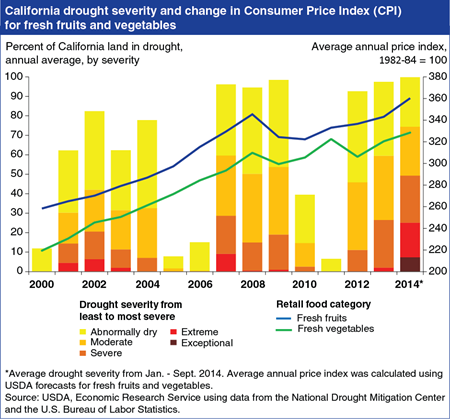
Thursday, October 30, 2014
The severity and duration of the ongoing drought in California has raised concerns over its role in rising food prices at the grocery store, especially for fresh fruits and vegetables. In 2012, California produced nearly 50 percent (by value) of the nation’s vegetables and non-citrus fruit. Droughts in California are generally associated with higher retail prices for produce, but price increases are lagged due to the time it takes for weather conditions and planting decisions to alter crop production, which then influence retail prices. In 2005, following five years of drought, retail fruit prices rose 3.7 percent and retail vegetable prices increased 4 percent. Prices continued to rise in 2006, one year after drought conditions began to improve. However, other factors such as energy prices and consumer demand also affect retail produce prices. For example, prices for fresh produce fell in 2009 despite drought conditions, as the 2007-09 recession reduced foreign and domestic demand for many retail foods. As of October 2014, ERS analysts are forecasting fresh fruit prices to increase 4.5 to 5.5 percent in 2014 and vegetable prices to be 2 to 3 percent higher. This chart appears in the Food Prices and Consumers section of the 2014 California Drought page on the ERS website. Information on ERS’s food price forecasts can be found in ERS’s Food Price Outlook data product, updated October 24, 2014.
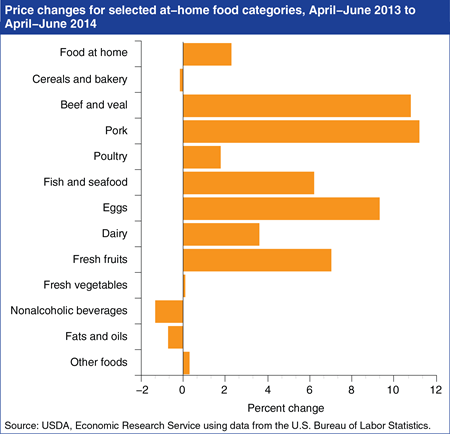
Tuesday, September 16, 2014
Retail food-at-home prices in the second quarter of 2014 were 2.3 percent higher than a year ago, as most at-home food categories increased in price. Retail beef and veal prices were up 10.8 percent as the supply of beef is strained by historically low herd sizes. Over the same time period, pork prices increased 11.2 percent, partially the result of the Porcine Epidemic Diarrhea virus, which has reduced litter sizes and increased piglet mortality. Egg prices are also up, in part due to increasing exports and a strong domestic demand for eggs and egg products. The increases in beef and veal, pork, and egg prices are the largest year-over-year increases since the fourth quarter of 2011. This chart appears in the Food Prices and Spending section of ERS’s Ag and Food Statistics: Charting the Essentials data product, updated September 10, 2014. More information on ERS’s food price forecasts can also be found in ERS’s Food Price Outlook data product.
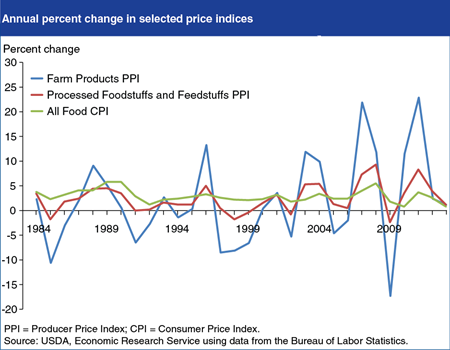
Tuesday, May 20, 2014
Droughts, floods, and other shocks to farming can lead to swings in the prices paid for farm commodities. Volatility in farm commodity prices—measured by the Producer Price Index (PPI) for Farm Products—and in intermediate foods—measured by the PPI for Processed Foodstuffs and Feedstuffs—is often greater than price volatility in grocery stores and restaurants. Prices move in the same direction, but the magnitude of the price changes varies. For instance, in 2011 the Farm Products PPI rose by 23.6 percent, while the Processed Foodstuffs and Feedstuffs PPI increased by 8.3 percent and the Consumer Price Index (CPI) for All Food by 3.2 percent. Price fluctuations for intermediate and retail foods are muted relative to that of farm products because prices for these foods include processing, transportation, and marketing costs. According to ERS’s Food Dollar Series, farm and agribusiness costs only represented 10.8 cents of every dollar spent on food in 2011. This chart appears in “Food Price Transmissions from Farm to Retail” in the May 2014 issue of ERS’s Amber Waves magazine.
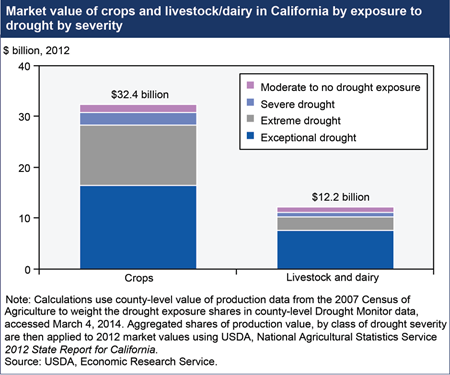
Thursday, May 8, 2014
The driest year on record for California, following several prior years of drought, is likely to have an impact on the State’s agricultural production in 2014. On January 17, 2014, the Governor of California declared a drought emergency and as of March 4, over 94 percent of California’s nearly $45 billion agricultural sector was experiencing severe, extreme, or exceptional drought. The livestock sector is more directly exposed to exceptional drought (about 62 percent) than the crop sector (just over 50 percent). Given that much of California’s agricultural production takes place on irrigated land, effects of the drought depend on the cost and availability of water from irrigation in addition to local rainfall. Shortages of irrigation water sourced from snowfall are already evident, and the extent to which growers will be able to offset these reduced surface water supplies by pumping groundwater is uncertain. Find the table underlying this chart and additional analysis in California Drought 2014: Farm and Food Impacts.
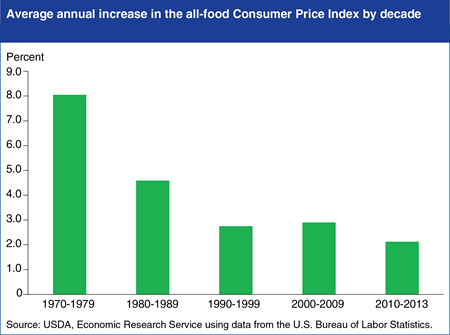
Wednesday, May 7, 2014
On average, food price inflation in the United States has been falling over the past several decades. Since 2010, food prices have risen by an average of 2.1 percent a year. By contrast, the 1970s saw the all-food Consumer Price Index (CPI) increase by an average of 8.1 percent annually, led by increases of 14.5 and 14.3 percent in 1973 and 1974, respectively. The 1970s were a time of high energy prices and high inflation for consumer goods, including food. In the 1980s, the all-food CPI increased by an average of 4.6 percent per year, and food prices rose 2 to 3 percent per year in the following two decades. Advancements in agricultural productivity contributed to falling inflation-adjusted prices for agricultural commodities during the 1980s and 1990s. In addition, enhanced agricultural trade has allowed the U.S. food supply to better respond to supply shocks. This chart appears in "Food Prices—Taking the Long-Term View" in ERS’s April 2014 Amber Waves magazine.
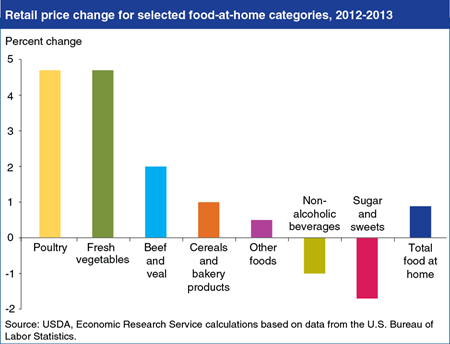
Tuesday, April 1, 2014
Grocery store food prices increased 0.9 percent in 2013. Since 1970, annual food-at-home price inflation has only been lower three times—in 1992, 2009, and 2010. Low food price inflation usually indicates that prices in some categories increased modestly while others fell, and that was the case in 2013. The largest increases were for poultry and fresh vegetables, which both rose by nearly 5 percent. Poultry price increases were driven by high feed prices and strong consumer demand in response to high beef and pork prices in 2011 and 2012. Vegetable prices rebounded from heavy deflation in 2012. Global sugar and coffee prices fell substantially in 2013, causing retail prices for the broader nonalcoholic beverages and sugar and sweets categories to fall as well. The other foods category, which constitutes over 10 percent of food spending, was nearly flat in 2013 due mostly to moderate fuel prices which lowered processing, packaging, and transportation costs. More information on food price changes and forecasts can be found in ERS’s Food Price Outlook data product, updated March 25, 2014.

Thursday, February 20, 2014
Since 2006, a series of factors—including spikes in energy prices, inflation-adjusted price increases for agricultural commodities, major weather events, expanding global food demand, and the U.S. economic recession and subsequent recovery—have caused price inflation for food to outpace many other consumer spending categories. The all-items CPI is a measure of economy-wide inflation covering all consumer purchases of goods and services. Between 2006 and 2013, the all-items CPI increased by slightly more than 15 percent. During the same time, the all-food CPI was up more than 21 percent, indicating that food has become relatively more expensive for U.S. households over this time period. Among the major expenditure categories tracked by the U.S. Bureau of Labor Statistics, only prices for medical care have risen faster than food prices. The all-food CPI increased 1.4 percent in 2013, below the average of 2.8 percent for the last 20 years. Food price inflation is expected to be between 2.5 and 3.5 percent in 2014. This chart appears in ERS’s data product, Ag and Food Statistics: Charting the Essentials, updated February 11, 2014.
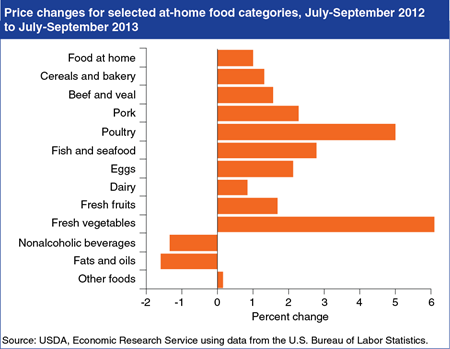
Friday, December 13, 2013
The food-at-home CPI for the third quarter of 2013 rose 1 percent from the third quarter of 2012. Historically, food prices have risen approximately 2.5 percent per year, indicating that this was a period of relatively low food price inflation. Fresh vegetable prices increased the most, as prices continue to rebound from the lows of 2012 that resulted from bumper crops for many vegetables. Poultry prices were up 5 percent from the third quarter of 2012, as higher feed prices and strong demand have resulted in steadily rising grocery store prices for chicken for much of 2013. Prices for nonalcoholic beverages as well as fats and oils are down since the third quarter of 2012, due in part to low global prices for coffee and soybeans. This chart is from ERS’s data product, Ag and Food Statistics: Charting the Essentials, updated December 9, 2013.
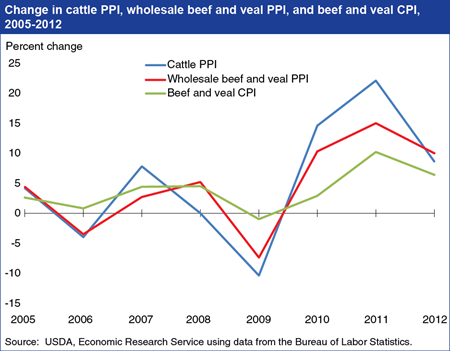
Thursday, November 7, 2013
Meat prices were expected to rise sharply in the wake of the 2012 drought, but this has not been the case. Higher feed prices, due in part to the 2012 drought, prompted ranchers to reduce herd sizes and send more animals to slaughterhouses than usual. This influx of livestock caused cattle prices, and in turn wholesale beef and veal prices, to increase less in 2012 than in 2011, as measured by the Bureau of Labor Statistics’ Producer Price Index (PPI). In 2012, the cattle PPI and wholesale beef and veal PPI increased by 8.6 and 10 percent, respectively, below the increases of 22.1 and 15 percent in 2011. While retail prices, as measured by the Consumer Price Index (CPI), track changes in the PPI, the swings are typically smaller. The beef and veal CPI rose by 6.4 percent in 2012 versus 10.2 percent in 2011. More information on food prices can be found in ERS’s Food Price Outlook data product, updated November 5, 2013.
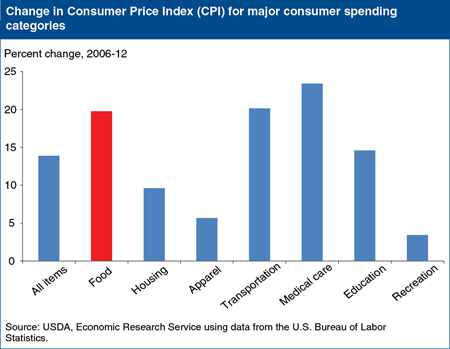
Tuesday, August 27, 2013
For most of the last two decades, the all-food Consumer Price Index (CPI) has followed a fairly predictable pattern of about 2-3 percent inflation each year. However, since 2006, a series of interrelated factors—including spikes in energy prices, major weather events, shocks to global food commodity markets, and the U.S. economic recession and subsequent recovery—have resulted in annual changes in the all-food CPI ranging from a 0.8-percent increase in 2010 to a 5.5-percent jump in 2008. Along with this heightened volatility, food price increases have outpaced increases in the all-items CPI, largely due to rising U.S. farm prices for corn, wheat, soybeans, and other food commodities driving up food prices. Between 2006 and 2012, the all-food CPI rose close to 20 percent compared with a 14-percent increase in the all-items CPI. Among major consumer spending categories, only prices for transportation, which includes a number of energy price measures, and medical care have risen faster than food prices. This chart appears in “Price Inflation for Food Outpacing Many Other Spending Categories” in ERS’s Amber Waves magazine, August 2013.

Wednesday, August 14, 2013
Due to inflation—the general fall in the purchasing power of money over time—shelf prices of most foods in the supermarket tend to rise a bit each year. However, by holding the value of the U.S. dollar constant at a particular point in time, it is possible to see how U.S. grocery store food prices have changed over time in real, inflation-adjusted terms. In real terms, bananas, tomatoes, eggs, and chicken are all cheaper today than they were in 1984. Bread, however, has grown more expensive. Real food prices are largely determined by supply-and-demand conditions. Increases in U.S. production, imports, or both have pushed down real prices of bananas and tomatoes, and production efficiencies have helped lower real prices for chicken and eggs. The greater variability of real prices of tomatoes and eggs reflects, in part, supplies that shift more dramatically from year to year as compared to bread, bananas, and chicken. Alternatively, real prices of major field crops, including wheat, have been increasing since 2002, resulting in higher real bread prices beginning around that time. More information on food price changes and forecasts can be found in ERS’s Food Price Outlook data product, updated July 24, 2013.

Wednesday, May 22, 2013
Memorial Day weekend kicks off the barbecue season for many Americans, and a grilled burger topped with cheese is a holiday staple. Using price data from the U.S. Bureau of Labor Statistics, ERS calculated the average national cost of a home-cooked cheeseburger. The cost was found to vary seasonally, usually decreasing in February, May, and June while reaching annual peaks in November or December. Most of the seasonal variation is due to the changes in beef prices. The April 2013 cost of $2.07 for a home-prepared cheeseburger is up 61 percent since 2000, while overall food-at-home prices have increased 41 percent in that time. Much of that difference is due to the strong beef price inflation of recent years resulting from low cattle inventories and high feed prices. More information on food price changes and forecasts can be found in ERS’s Food Price Outlook data product.
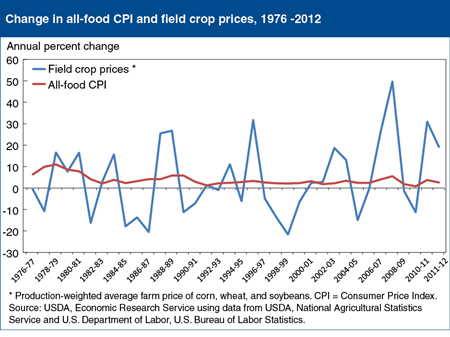
Tuesday, April 23, 2013
Farm-level commodity prices are far more volatile than food prices, as costs for marketing inputs such as packaging, processing, and transportation mitigate commodity price volatility on supermarket shelves and restaurant menus. Corn, wheat, and soybeans are the three most important field crops to the U.S. food supply. The average farm price of these crops, weighted by total production, regularly rises or falls by over 10 percent from year to year. On average, food prices have become less volatile in recent decades, as food price inflation averaged 8 percent per year in the 1970s, but only 2.8 percent per year since 1990. Commodity prices, alternatively, have grown somewhat more volatile over time. However, large changes in major commodity prices have relatively small impacts on food prices. In 2007-08, the average production-weighted price of these crops increased by 50 percent, while food prices rose 5.5 percent. Similarly, in 2010-11, the crop prices rose 31 percent and food prices increased 3.7 percent. This chart appears in the Food Price Outlook topic page on the ERS website, updated April 17, 2013.

Tuesday, February 19, 2013
In the final three months of 2012, higher field corn prices resulting from the Midwest drought began to show up on supermarket shelves. From October to December, while the all-items CPI fell 0.8 percent and overall food-at-home prices increased only 0.2 percent, prices rose for most foods that rely heavily on corn-based animal feed—beef, pork, poultry, other meats, eggs, and dairy products. Milk prices rose nearly 3 percent while egg prices increased 1.7 percent. Prices for beef, poultry, and other meats all rose by about 0.5 percent. The only animal-based category defying this trend is pork, where rising inventories and falling exports have caused retail prices to drop from historically high levels in early 2012. ERS forecasts prices for all meat and animal-based products to increase steadily through the first half of 2013. More information on food price changes and forecasts can be found in the Food Price Outlook data product, updated January 2013.
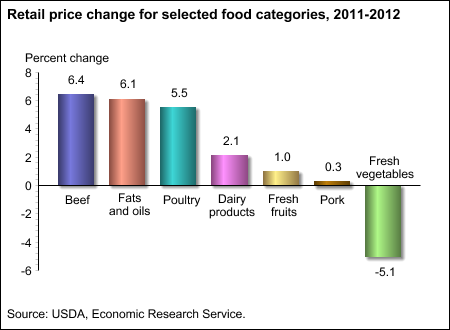
Wednesday, January 30, 2013
Overall food-at-home prices rose 2.6 percent in 2012, but this masked a great deal of variation across food categories. For the second consecutive year, beef and fats and oils showed the biggest percentage increases. Beef prices increased due to record low cattle inventories, while surging soybean prices pushed up prices for fats and oils. Poultry prices also increased substantially in 2012, due to a shift in demand away from high-priced beef and pork coupled with higher costs for broiler feed resulting from the Midwest drought. Pork prices, which saw major inflation in 2011, were flat in 2012 as wholesale prices fell due to rising hog inventories and falling exports. Vegetable prices fell 5.1 percent in 2012 as the unusually warm weather led to bumper crops for lettuce, tomatoes, and other vegetables, in sharp contrast to the poor harvests and high vegetable prices of 2011. More information on food price changes and forecasts can be found in the Food Price Outlook data product, updated January 24, 2013.
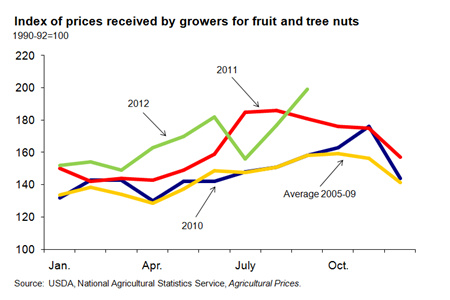
Friday, October 19, 2012
The index of prices received by fruit and tree nut growers in September rose above year-ago levels after falling behind in July and August of this year. At 199 (1990-92=100), the index reported in September increased 18 percent from the September 2011 index. Despite a significant decline in fresh lemon prices, grower price increases for fresh grapefruit, oranges, apples, grapes, peaches, pears, and strawberries in September boosted this year's September index. Unfavorable weather this growing season reduced production of most these crops, driving up their prices. Consumer prices for fresh fruit, however, declined 1 percent relative to last year. This chart updates the version from the Fruit and Tree Nut Outlook, FTS-353, September 2012.
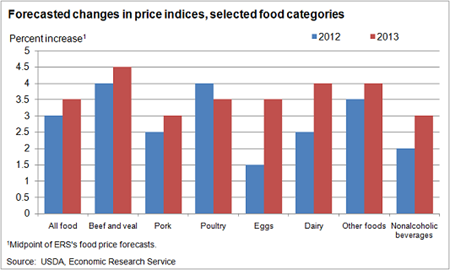
Wednesday, August 1, 2012
Overall food prices remain on track to increase by 2.5 to 3.5 percent in 2012, but are forecast to increase 3 to 4 percent in 2013. Food price inflation in 2013 is expected to be higher than normal due to the ongoing drought in the Midwest. The drought has driven up commodity prices, particularly field corn, used as animal feed and a food ingredient. Higher feed costs are expected to push up retail prices for beef, pork, dairy products, and eggs in 2013. ERS expects poultry prices to increase more in 2012 than in 2013, as feed costs impact prices for smaller animals faster. Price inflation for packaged and processed foods (other foods) is forecast to be in the 3.5 to 4.5 percent range for 2013, as higher corn prices are transmitted over the coming year into higher prices for corn flour and corn syrup--common ingredients in processed foods. More expensive high fructose corn syrup is expected to boost non-alcoholic beverage prices in 2013 as well. More information on food price changes and forecasts can be found in the Food Price Outlook data product on the ERS website, updated July 25, 2012.

Monday, July 2, 2012
For most food categories and for food at home in general, prices in the first quarter of 2012 were higher than they were a year ago. Consumers faced 4.5 percent higher food prices on average at the grocery store in January-March 2012, compared to January-March 2011. Fats and oils prices were 11.3 percent higher in first quarter 2012 versus first quarter 2011, and beef prices were 8.5 percent higher. However, the warm 2011-12 winter and favorable growing conditions resulted in a year-over-year decrease in produce prices for the first quarter of 2012, with fruit prices down 1.1 percent and vegetable prices down 7.4 percent. More information on food price changes and forecasts can be found in the Food Price Outlook data product on the ERS website, updated June 25, 2012.


